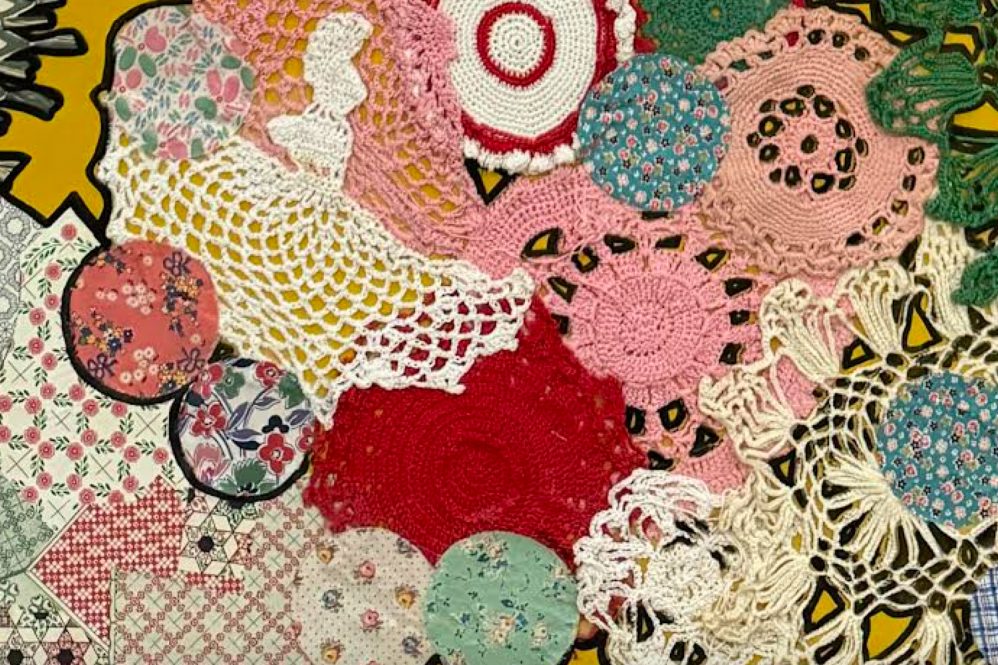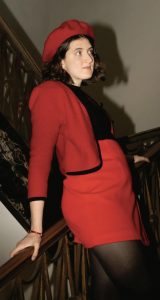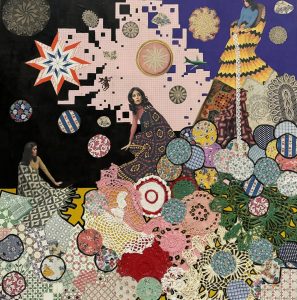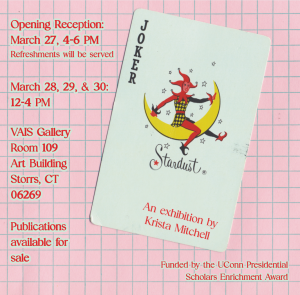'Joker Stardust,' on display March 27-30, started as a critique of consumerism inspired by the 1980s but eventually morphed into a multilayered project focused on the 1960s and 1970s that asks the question, 'Who am I?'

Krista Mitchell '25 (SFA, CLAS) made a 3-by-3-foot collage for her upcoming art exhibition, "Joker Stardust," that includes doilies handmade by her grandmother. (Courtesy of Krista Mitchell)
Sure, in her spare time growing up Krista Mitchell did what any only child might do to keep busy - doodle in a notebook, design a maze like the one in her coloring book, devote hours to reading.
But Mitchell '25 (SFA, CLAS) says she often took those projects to the nth degree.

"I actually made a household newspaper in which I wrote the articles and drew pictures to go with them. I even used to go crazy sending thank you cards to my family. I would do these elaborate drawings on the envelopes to the point that the post office would send them back because they couldn't read the addresses," she says. "So, yeah, I've always been very creative."
There should be no surprise then when, as a high school senior, she used an assignment to make an animal mask as an opportunity to build giant luna moth wings large enough for an adult to wear.
And that final project for a basic photography class at UConn, of course it became the basis for a presentation at the Humanities Undergraduate Research Symposium last year and the reason she was asked to talk during a Humanities Institute conversation on the loneliness epidemic in the fall.
You bet, it even got her an on-air interview with Connecticut Public Radio.
"All of this was absolutely meant to be," she says. "It all just happened, honestly."
In the same way, she sort of fell into her latest project, "Joker Stardust," an art exhibition on display this week that she says started as a critique of consumerism inspired by the 1980s but eventually morphed into a multilayered project focused on the 1960s and 1970s that asks the question, "Who am I?"
Well, who is Krista Mitchell?
Mitchell, a double major in English and art who'll graduate in December, says she started at UConn planning to exclusively major in English and eventually embark on a career as a journalist or teacher. After all, in high school, she'd had success in various writing contests and people always told her she was a good writer.

But that first year in college, she found herself drowning in the largeness of the University and escaped in the safety of her art minor.
"I took my first art class, Drawing I, and noticed it gave me something I could channel my energy into," she says. "I felt safe in the small classes where everybody knew who I was, and the teacher actually cared about me. She was the one who said, 'Krista, there's something about your artwork that is special. I don't know what it is, but you have something, and I think you should keep going with it.' That's pretty high praise for someone who was just starting."
That's the thing about art, she notes, "People think they can't do it, but everyone has it in them. You just have to slow down and study your surroundings."
A passion for art started to grow inside her, so elevating it to a second major was a no-brainer. She elected the Bachelor of Arts track in the art and art history department over the Bachelor of Fine Arts because it allowed her to generalize her courses, rather than pick a specific concentration.
If she had to pick, she says, she would have opted for animation and illustration - you might have seen her regular comics and illustrations in The Daily Campus - and that would have been the wrong choice, knowing what she knows now.
"Doing this project, 'Joker Stardust,' has shown me that I would be a painting and drawing major because animation and illustration is more about communicating something for an editorial purpose or storytelling and making characters. My mind doesn't work like that. I'm more of a conceptual person," she says.
She likes the bright colors of pop art, and things another person might describe as being "off" or just a little bit "creepy," like those baby dolls whose eyelids open when upright and close when reclined.
She absolutely loves liminal spaces like empty parking lots at night with only the overhead lights illuminated, giving an eerie glow to a familiar place. Candles also are a favorite, if only for the impermanence they represent.
And, vaporwave, oh vaporwave, the aesthetic that pulls from the 1980s and 1990s is close to her heart, along with fashions from the 1960s and 1970s that she finds at thrift shops and wears around campus: cloth hairbands, chunky-heeled shoes, blazers with pinstriped lapels, and miniskirts.
"I know what my vision is as an artist, and I'm able to apply it to a lot of different mediums," she says. "I say that now, but I know in a couple years, I'll again say, 'I don't know who I am,' because that's part of being an artist. You go through these phases of 'Who am I?' Fortunately, right now, I'm in a phase where I feel confident."
But is everything by chance?
In coming to UConn, Mitchell received the Presidential Scholars Enrichment Award, giving her $2,500 for a project of her choosing. But one must choose carefully, and Mitchell mulled ideas for three years. Publishing a book seemed most logical. Then, she saw an art exhibition last spring from Irene Pham '24 (SFA), a solo show that included paintings about Pham's family, immigration, and the mixed feelings she had about the two.
Mitchell had taken Art 1010, "Foundation: Studio Concepts," with associate professor John O'Donnell early on in her studies and liked his teaching style. Plus, they share an affinity for vaporwave.
"I sent him an email with an independent study proposal, explaining I wanted to do an exhibition. It was one of the longest emails I ever wrote, and amazingly he agreed. He hardly knew me, but he did remember me," she says. "I'm so grateful to him because this has changed my life."
O'Donnell suggested she make a series of collages and use her time over the summer of 2024 to purchase panels of varying sizes and rummage second-hand stores for magazines, books, and other items.

Mitchell was close with her maternal grandmother, Catherine "Kay" Holloway, who left behind a treasure trove of collections and her own art creations when she died in 2015. Holloway didn't have any formal art training, but was artistic, and Mitchell says she inherited things like her fondness for antiques and oddities from her.
With O'Donnell's advice in mind, Mitchell poured through her grandparents' home, taking handmade doilies, handwritten sewing patterns, hand drawn five-point stars, among other things like Kewpie dolls, stained curtains, a half-drained Snoopy snow globe, and pink graph paper.
"The thing with collages," Mitchell explains, "it's kind of like you're going through an archive and taking the history of these objects and putting them in a new story. You're almost recontextualizing them."
She spent at least a hundred hours cutting out pictures from magazines like Ladies' Home Journal and Reader's Digest and sorting images of Hummel figurines, angels, and Barbie dolls.
That way, when winter break came early this year, she could start creating, again with O'Donnell's words in mind reminding her to choose items intentionally, as if to tell a story, and not just for decoration.
As she did, questions started swirling in her head: Why am I so much like my grandmother? Why am I like this? Why do I dress like this? Why do I like this stuff? The theme of consumerism muted to make room for concepts like individual creativity, religion, the meaning of life, and what happens after death.
"I started to think about what this all could mean and what I landed on was one idea," she says. "Could the belief that there is some sort of greater meaning to life or higher power give people an incentive to create with intention?
"That's when I realized I love a lot of this stuff because of the history behind it. My grandmother was very careful about building her collection of seemingly random things. She had her own artistic vision, and she was very intentional with how she did things and how they reflected the story she was trying to tell.
"Like, I don't know who owned this, but somebody did before I did," Mitchell says, tugging at her second-hand jacket. "That's kind of mysterious and interesting, right? There is something greater that connects me to my grandmother, that connects me to these interests I have, the way I dress, and the aesthetics of these previous time periods."
None of the 25 collages are titled, Mitchell says, and that's intentional because they're supposed to resemble things one might find at an antique store. As for the title of the show, "Joker Stardust," that was purposeful, based on a joker card she found at her grandparents'.

"Is everything around us by chance? Is it a joke or is there some sort of divine power making the world as it is or is it random," Mitchell asks, adding that "stardust" hearkens to the 1970s David Bowie character Ziggy Stardust.
As part of the project, she ended up publishing a book, putting her writing skills to use as she penned thoughts on each collage. She has 20 copies of "Joker Stardust" in her possession, some of which will be for sale during the show's opening Thursday, March 27.
"My parents have always been very supportive, all through school, helping me with stuff like this project. They've always been there, which I'm very grateful for," she says.
In the show, Mitchell says she's placed a mirror, with the idea that you see not just your reflection but also those family members who came before you. How did these people find each other, she asks, because without them there wouldn't be you.
And without stardust, there wouldn't be anything.
"Joker Stardust" will open Thursday, March 27, in the VAIS Gallery, Room 109, in the Art Building on the Storrs campus. A reception will be held from 4 to 6 p.m. The show will be open Friday, March 28, through Sunday, March 30, from noon to 4 p.m.






